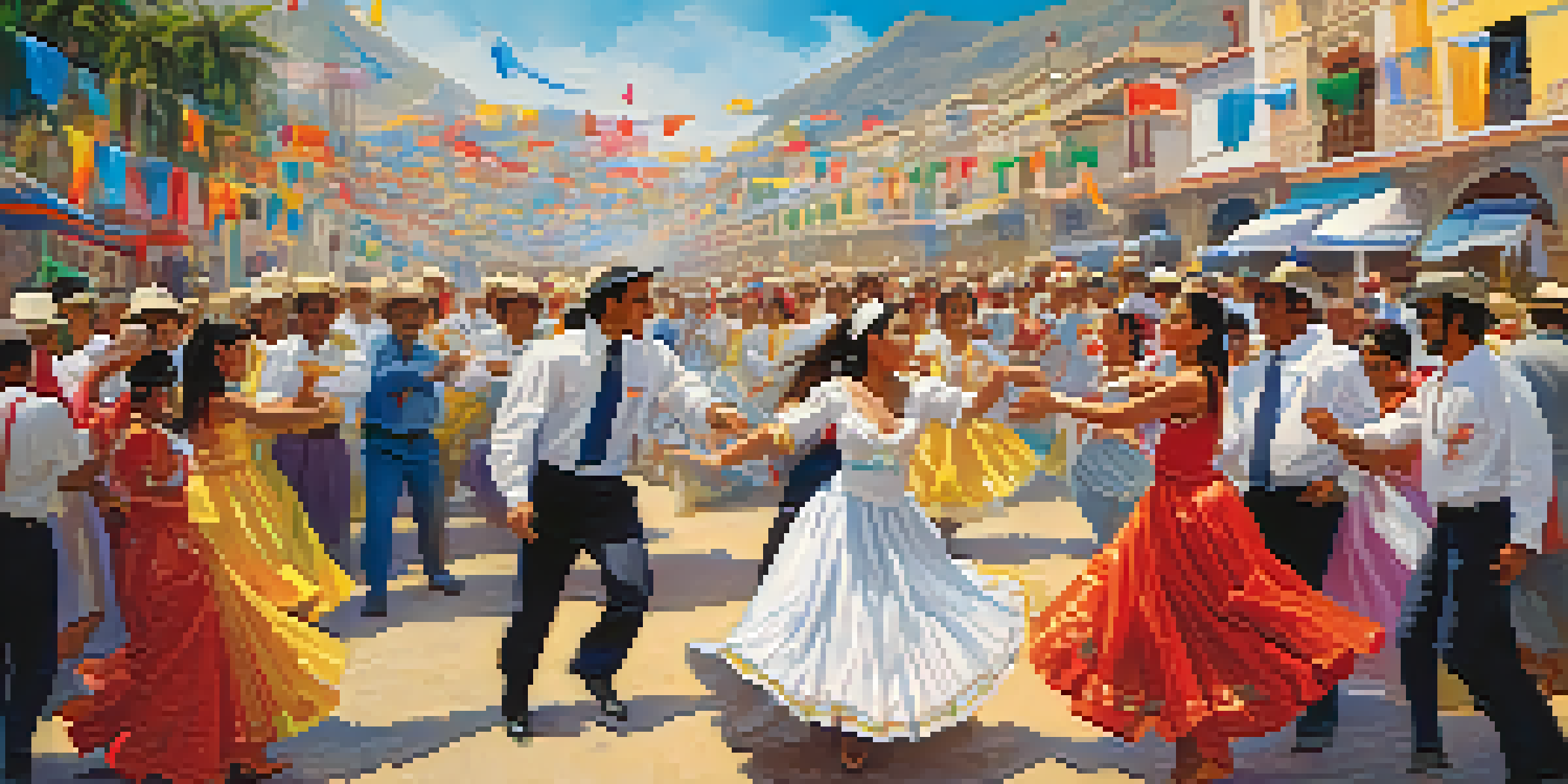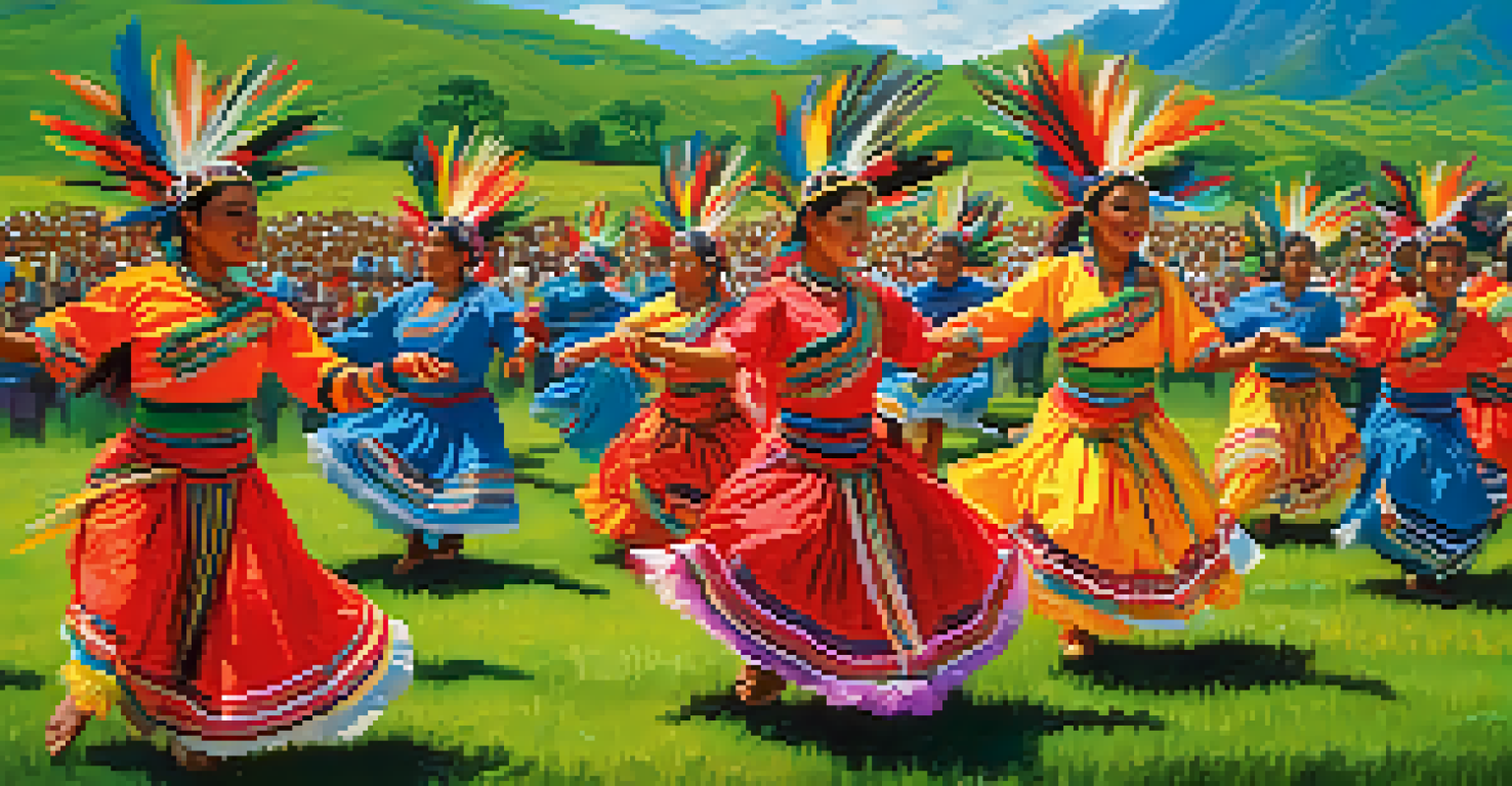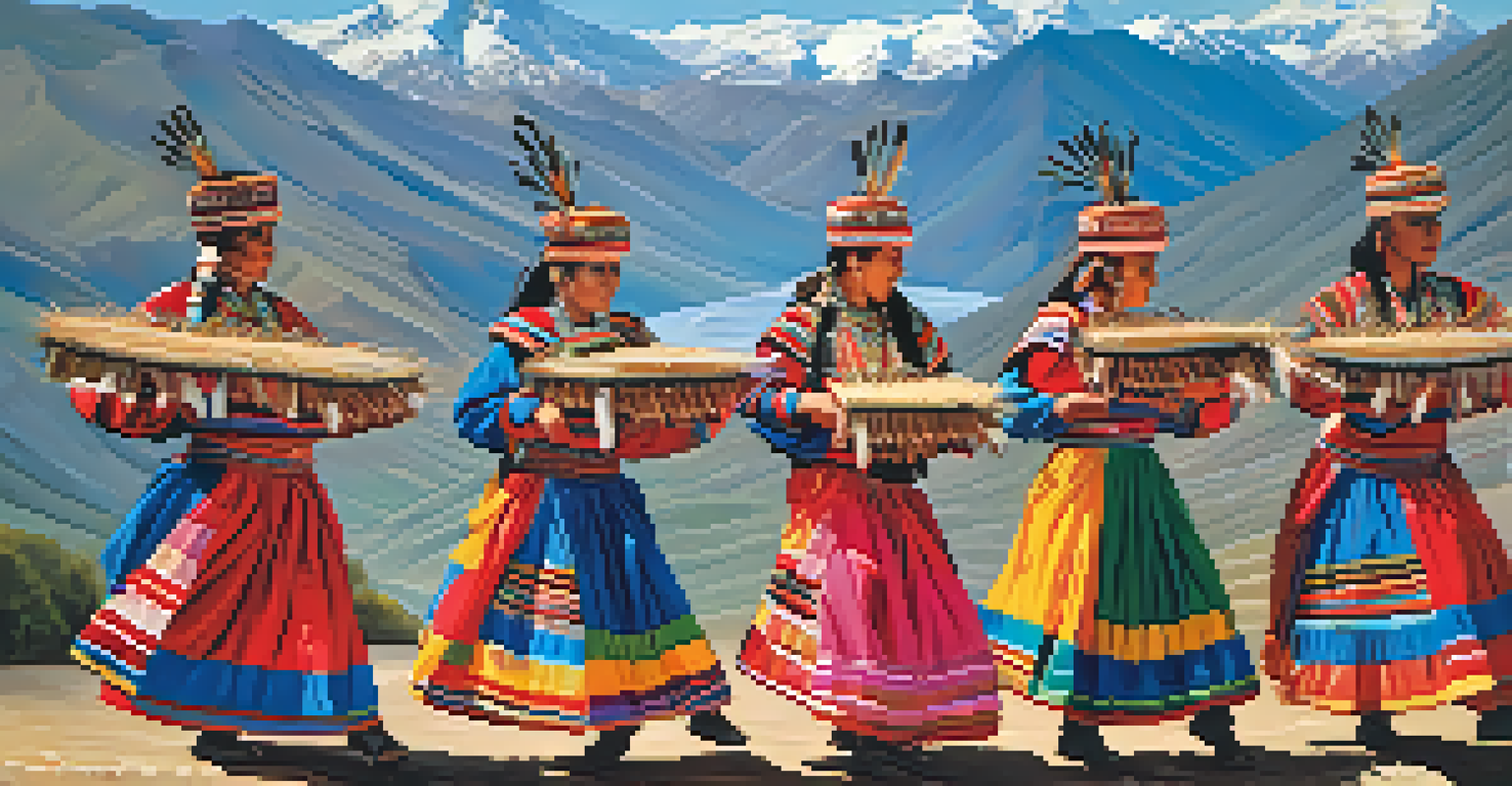Traditional Peruvian Dances: Rhythm and Cultural Stories

The Heartbeat of Peru: An Introduction to Traditional Dance
Traditional Peruvian dances are more than just entertainment; they are a reflection of the country's rich history and diverse cultures. Each dance tells a story, often rooted in ancient rituals, festivals, or everyday life. From the lively streets of Lima to the highlands of Cusco, these dances embody the spirit and resilience of the Peruvian people.
Dance is the hidden language of the soul.
The rhythms of these dances are infectious, inviting participation from all who witness them. They serve as a vibrant means of expressing joy, sorrow, and community. Whether performed during a festival or a family gathering, each dance is an invitation to connect with Peruvian culture on a deeper level.
In this article, we will explore some of the most iconic traditional dances, uncovering their origins, meanings, and the cultural narratives they convey. Join us as we journey through Peru's colorful tapestry of rhythm and storytelling.
Marinera: The Dance of Love and Courtship
One of the most beloved traditional dances in Peru is the Marinera, often seen as a symbol of love and courtship. This elegant dance showcases the flirtation between a man and a woman, characterized by graceful movements and intricate footwork. The dancers typically wear traditional clothing, with the woman donning a flowing white dress and the man dressed in a classic suit.

Originating from the coastal regions of Peru, the Marinera also reflects the coastal lifestyle and the harmony between the sea and its people. The dance is often performed during festivals, with participants showcasing their skills in competitions that draw crowds from all over. Its lively music, played with guitars and percussion, adds to the overall charm and excitement of the performance.
Traditional Dances Reflect Culture
Peruvian traditional dances serve as vibrant expressions of the country's rich history and diverse cultural narratives.
Through the Marinera, we see a beautiful representation of Peru’s romantic traditions. This dance not only entertains but also serves as a reminder of the importance of love and connection in Peruvian society.
Huaylash: A Celebration of Andean Culture
The Huaylash is a traditional dance deeply rooted in the Andean culture of Peru, particularly among the communities in the Huánuco region. This dance is often performed during agricultural festivals, celebrating the harvest and the hardworking spirit of the Andean people. Its lively tempo and dynamic movements reflect the energy and resilience of the mountain communities.
To be yourself in a world that is constantly trying to make you something else is the greatest accomplishment.
Dancers usually wear colorful costumes adorned with traditional motifs, representing their cultural heritage. The rhythmic stomping and clapping create a vibrant atmosphere that encourages audience participation. The Huaylash is not just a dance; it’s a communal expression of gratitude for the land and its bountiful offerings.
Through the Huaylash, we gain insight into the daily lives and values of the Andean people. It's a dance that bridges generations, passing down stories and traditions from one era to the next, embodying the spirit of community.
Sikuri: The Dance of the Panpipes
The Sikuri is a captivating dance that highlights the importance of the panpipe, or siku, in Andean music. Originating from the Altiplano region, this dance is performed during festivals and celebrations, where the sound of panpipes fills the air. The dancers, often in large groups, move in synchronized formations, creating a visual spectacle that mirrors the harmony of the music.
Costumed in traditional attire, the dancers portray the connection between nature and music, reflecting the Andean worldview. The Sikuri is not only a dance but also a way to honor the spirits of the mountains and the earth. Each performance resonates with the rhythms of life, intertwining the past and present.
Dance as a Community Connector
These dances foster community connections by inviting participation and celebration of shared heritage during festivals and gatherings.
By participating in the Sikuri, dancers and audiences alike celebrate their cultural identity and heritage. This dance embodies the unity and resilience of Andean communities, showcasing how music and movement can convey deep cultural narratives.
La Fiesta de la Candelaria: A Cultural Extravaganza
La Fiesta de la Candelaria is one of the most significant festivals in Peru, celebrated in Puno every February. This vibrant event showcases a variety of traditional dances, including the Diablada and Morenada, each with its own unique story and cultural significance. The festival attracts thousands of participants and spectators, turning the city into a kaleidoscope of color and rhythm.
During the festival, dancers don elaborate costumes that often symbolize the struggles and victories of the indigenous people. The Diablada, for example, represents the battle between good and evil, while the Morenada pays homage to the African slaves who contributed to Peruvian culture. Each dance during the festival serves as a reminder of the rich tapestry of Peru's history.
La Fiesta de la Candelaria is more than just a celebration; it’s a powerful expression of cultural pride and identity. By participating in this festival, dancers and audiences alike connect with their heritage, ensuring that these traditional stories are passed down to future generations.
The Influence of Traditional Dance on Modern Peruvian Culture
Traditional Peruvian dances have significantly influenced contemporary culture, inspiring artists, musicians, and performers across the nation. Many modern dance troupes incorporate traditional elements into their performances, blending old and new to create innovative expressions of culture. This fusion not only keeps the traditions alive but also introduces them to new audiences.
Additionally, traditional dances are increasingly featured in tourism, showcasing Peru's rich cultural heritage to visitors from around the world. Dance workshops and cultural festivals allow tourists to engage with these traditions firsthand, fostering a deeper appreciation for Peru's diverse cultural landscape. Through this exchange, traditional dances continue to evolve while remaining rooted in their historical significance.
Preservation of Cultural Heritage
Efforts to preserve traditional Peruvian dances ensure that cultural stories and values are passed down to future generations.
As modern society progresses, traditional Peruvian dances serve as a reminder of the importance of cultural identity. They provide a sense of belonging and continuity, connecting people to their past while inspiring future generations to embrace and celebrate their heritage.
Preserving the Legacy of Traditional Peruvian Dances
The preservation of traditional Peruvian dances is crucial in maintaining the country’s cultural heritage. Various organizations and cultural groups work tirelessly to document and promote these dances, ensuring that their significance is recognized and cherished. Workshops and educational programs are being established to teach younger generations the art of traditional dance, fostering pride in their cultural roots.
Community involvement plays a vital role in this preservation effort. Local festivals and events often feature traditional dances, inviting community members to participate and share their stories. By engaging with these dances, people from all walks of life can contribute to the preservation of their cultural identity, creating a sense of ownership and pride.

Through these efforts, traditional Peruvian dances will continue to thrive, passing down stories and values from one generation to the next. This commitment to preservation highlights the importance of keeping cultural narratives alive in an ever-changing world.
Conclusion: The Power of Dance in Cultural Storytelling
Traditional Peruvian dances serve as powerful vehicles for storytelling, weaving together history, culture, and community. Each dance encapsulates the essence of the people, reflecting their joys, struggles, and aspirations. As we explore these vibrant dances, we gain insight into the rich tapestry of Peruvian culture, fostering a deeper appreciation for its diversity.
In a world that often feels disconnected, traditional dances remind us of the importance of community and shared experiences. They encourage us to celebrate our heritage while inviting others to join in the dance of life. By embracing these cultural narratives, we contribute to a collective story that transcends generations.
As we conclude our journey through the rhythm and stories of traditional Peruvian dances, let us carry these lessons forward. Through dance, we can connect, celebrate, and honor the diverse cultures that enrich our global tapestry.